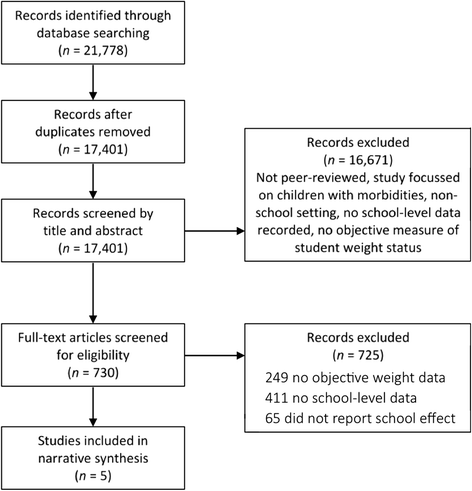A systematic review of how researchers characterize the school environment in determining its effect on student obesity
- PMID: 26217528
- PMCID: PMC4511531
- DOI: 10.1186/s40608-015-0045-5
A systematic review of how researchers characterize the school environment in determining its effect on student obesity
Abstract
Background: Obesity in early childhood is a robust predictor of obesity later in life. Schools provide unparalleled access to children and have subsequently become major intervention sites. However, empirical evidence supporting the effectiveness of school-based interventions against childhood obesity is of limited scope and unknown quality. The aim of this systematic review is to critically assess how researchers have characterized the school environment in determining its effect on childhood weight status in order to improve the quality and consistency of research in this area. We conducted a narrative review with a systematic search of the literature in line with PRISMA guidelines (2009). Original peer-reviewed research articles in English were searched from Medline, EMBASE, CENTRAL, CINAHL and PsycINFO databases from earliest record to January 2014. We included empirical research that reported at least one measure of the primary/elementary school environment and its relationship with at least one objective adiposity-related variable for students aged 4-12 years. Two authors independently extracted data on study design, school-level factors, student weight status, type of analysis and effect.
Results: Five studies met the inclusion criteria. Each study targeted different parts of the school environment and findings across the studies were not comparable. The instruments used to collect school-level data report no validity or reliability testing.
Conclusions: Our review shows that researchers have used instruments of unknown quality to test if the school environment is a determinant of childhood obesity, which raises broader questions about the impact that schools can play in obesity prevention.
Keywords: Childhood obesity; Environmental measurement; School.
Figures
Similar articles
-
Association between pacifier use and breast-feeding, sudden infant death syndrome, infection and dental malocclusion.JBI Libr Syst Rev. 2005;3(6):1-33. doi: 10.11124/01938924-200503060-00001. JBI Libr Syst Rev. 2005. PMID: 27819973
-
The Effectiveness of Integrated Care Pathways for Adults and Children in Health Care Settings: A Systematic Review.JBI Libr Syst Rev. 2009;7(3):80-129. doi: 10.11124/01938924-200907030-00001. JBI Libr Syst Rev. 2009. PMID: 27820426
-
School-level factors associated with obesity: A systematic review of longitudinal studies.Obes Rev. 2019 Jul;20(7):1016-1032. doi: 10.1111/obr.12852. Epub 2019 Apr 23. Obes Rev. 2019. PMID: 31013544
-
School-Based Interventions Targeting Nutrition and Physical Activity, and Body Weight Status of African Children: A Systematic Review.Nutrients. 2019 Dec 30;12(1):95. doi: 10.3390/nu12010095. Nutrients. 2019. PMID: 31905832 Free PMC article.
-
The effect of weight management interventions that include a diet component on weight-related outcomes in pregnant and postpartum women: a systematic review protocol.JBI Database System Rev Implement Rep. 2015 Jan;13(1):88-98. doi: 10.11124/jbisrir-2015-1812. JBI Database System Rev Implement Rep. 2015. PMID: 26447010
Cited by
-
Pathways of physical activity behavior after an intervention with students from vulnerable areas: a cluster randomized controlled trial based on a socioecological approach.Cad Saude Publica. 2024 Sep 27;40(9):e00138023. doi: 10.1590/0102-311XEN138023. eCollection 2024. Cad Saude Publica. 2024. PMID: 39536223 Free PMC article. Clinical Trial.
-
Association between the school physical activity environment, measured and self-reported student physical activity and active transport behaviours in Victoria, Australia.Int J Behav Nutr Phys Act. 2021 Jun 22;18(1):79. doi: 10.1186/s12966-021-01151-6. Int J Behav Nutr Phys Act. 2021. PMID: 34158052 Free PMC article.
-
A Systematic Review of the Bibliometrics and Methodological Research Used on Studies Focused on School Neighborhood Built Environment and the Physical Health of Children and Adolescents.Children (Basel). 2025 Jul 17;12(7):943. doi: 10.3390/children12070943. Children (Basel). 2025. PMID: 40723135 Free PMC article. Review.
-
Factors Influencing Adolescents' Dietary Behaviors in the School and Home Environment in Addis Ababa, Ethiopia.Front Public Health. 2022 Apr 8;10:861463. doi: 10.3389/fpubh.2022.861463. eCollection 2022. Front Public Health. 2022. PMID: 35462798 Free PMC article.
-
Development and reliability of an audit tool to assess the school physical activity environment across 12 countries.Int J Obes Suppl. 2015 Dec;5(Suppl 2):S36-42. doi: 10.1038/ijosup.2015.17. Epub 2015 Dec 8. Int J Obes Suppl. 2015. PMID: 27152183 Free PMC article.
References
-
- Australian Bureau of Statistics (ABS) Feature Article 1: Children who are overweight or obese. ABS: Canberra. 2009;10:1301.0.
-
- World Health Organization (WHO) Global strategy on diet, physical activity, and health, overweight and obesity. 2013.
-
- WHO . Population-based approaches to childhood obesity prevention. 2012.
Grants and funding
LinkOut - more resources
Full Text Sources
Other Literature Sources
Miscellaneous


